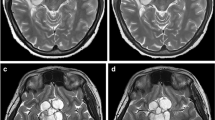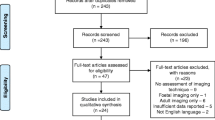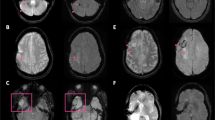Abstract
Background
Assessment of small brain lesions in children is often compromised by pulsation, flow or movement artefacts. MRI with a rotating blade-like k-space covering (BLADE, PROPELLER) can compensate for these artefacts.
Objective
We compared T2-weighted FLAIR images that were acquired with different k-space trajectories (conventional Cartesian and BLADE) to evaluate the impact of BLADE technique on the delineation of small or low-contrast brain lesions.
Materials and methods
The subject group comprised 26 children with neurofibromatosis type 1 (NF 1), who had been routinely scanned at 1.5 T for optic pathway gliomas with both techniques and who had the typical hyperintense brain lesions seen in NF 1. Four experienced radiologists retrospectively compared unlabelled 4-mm axial images with respect to the presence of artefacts, visibility of lesions, quality of contour and contrast.
Results
Both techniques were comparable in depicting hyperintense lesions as small as 2 mm independent of contrast and edge definition. Pulsation and movement artefacts were significantly less common with BLADE k-space trajectory. In 7 of 26 patients (27%), lesions and artefacts were rated as indistinguishable in conventional FLAIR, but not in BLADE FLAIR images.
Conclusion
BLADE imaging significantly improved the depiction of lesions in T2-W FLAIR images due to artefact reduction especially in the posterior fossa.





Similar content being viewed by others
References
Forbes KP, Pipe JG, Bird CR et al (2001) PROPELLER MRI: Clinical testing of a novel technique for quantification and compensation of head motion. J Magn Reson Imaging 14:215–222
Penzkofer AK, Pfluger T, Pochmann Y et al (2002) MR imaging of the brain in pediatric patients: diagnostic value of HASTE sequences. AJR 179:509–514
Alibek S, Adamietz B, Cavallaro A et al (2008) Contrast-enhanced T1-weighted fluid-attenuated inversion-recovery BLADE magnetic resonance imaging of the brain: an alternative to spin-echo technique for detection of brain lesions in the unsedated pediatric patient? Acad Radiol 15:986–995
Runge VM, Wood ML, Kaufman DM et al (1988) The straight and narrow path to good head and spine MRI. Radiographics 8:507–531
Kallmes DF, Hui FK, Mugler JP III (2001) Suppression of cerebrospinal fluid and blood flow artifacts in FLAIR MR imaging with a single-slab three-dimensional pulse sequence: initial experience. Radiographics 221:251–255
Naganawa S, Satake H, Iwano S et al (2008) Contrast-enhanced MR imaging of the brain using T1-weighted FLAIR with BLADE compared with a conventional spin-echo sequence. Eur Radiol 18:337–342
Forbes KP, Pipe JG, Karis JP et al (2002) Improved image quality and detection of acute cerebral infarction with PROPELLER diffusion-weighted MR imaging. Radiology 225:551–555
Wintersperger BJ, Runge VM, Biswas J et al (2006) Brain magnetic resonance imaging at 3 Tesla using BLADE compared with standard rectilinear data sampling. Invest Radio 41:586–592
Forbes KP, Pipe JG, Karis JP et al (2003) Brain imaging in the unsedated pediatric patient: comparison of periodically rotated overlapping parallel lines with enhanced reconstruction and single-shot fast spin-echo sequences. AJNR 24:794–798
Gill DS, Hyman SL, Steinberg A et al (2006) Age-related findings on MRI in neurofibromatosis type 1. Pediatr Radiol 36:1048–1056
Pipe JG (1999) Motion correction with PROPELLER MRI: application to head motion and free-breathing cardiac imaging. Magn Reson Med 42:963–969
Fleiss JL (1981) Statististical methods for rates and proportions, 2nd edn. Wiley, New York, p 432
Altman DG (1991) Practical statistics for medical research, 1st edn. Chapman and Hall, London, p 404
Böck JC, Neumann K, Sander B et al (1991) [Prepontine artifacts due to cerebrospinal fluid pulsation in the T2-weighted coronal MR picture. Clinical significance, frequency and a technique for artefact suppression.] RoFo 154:202-205
Maclaren JR, Bones PJ, Millane RP et al (2008) MRI with TRELLIS: a novel approach to motion correction. Magn Res Imaging 26:474–483
Iskandar BJ, Sansone JM, Medow J et al (2004) The use of quick-brain magnetic resonance imaging in the evaluation of shunt-treated hydrocephalus. J Neurosurg 101:147–151
Ba-Ssalamaha A, Schick S, Heimberger K et al (2000) Ultrafast magnetic resonance imaging of the brain. Magn Reson Imaging 18:237–243
Author information
Authors and Affiliations
Corresponding author
Rights and permissions
About this article
Cite this article
von Kalle, T., Blank, B., Fabig-Moritz, C. et al. Reduced artefacts and improved assessment of hyperintense brain lesions with BLADE MR imaging in patients with neurofibromatosis type 1. Pediatr Radiol 39, 1216–1222 (2009). https://doi.org/10.1007/s00247-009-1370-y
Received:
Revised:
Accepted:
Published:
Issue Date:
DOI: https://doi.org/10.1007/s00247-009-1370-y




